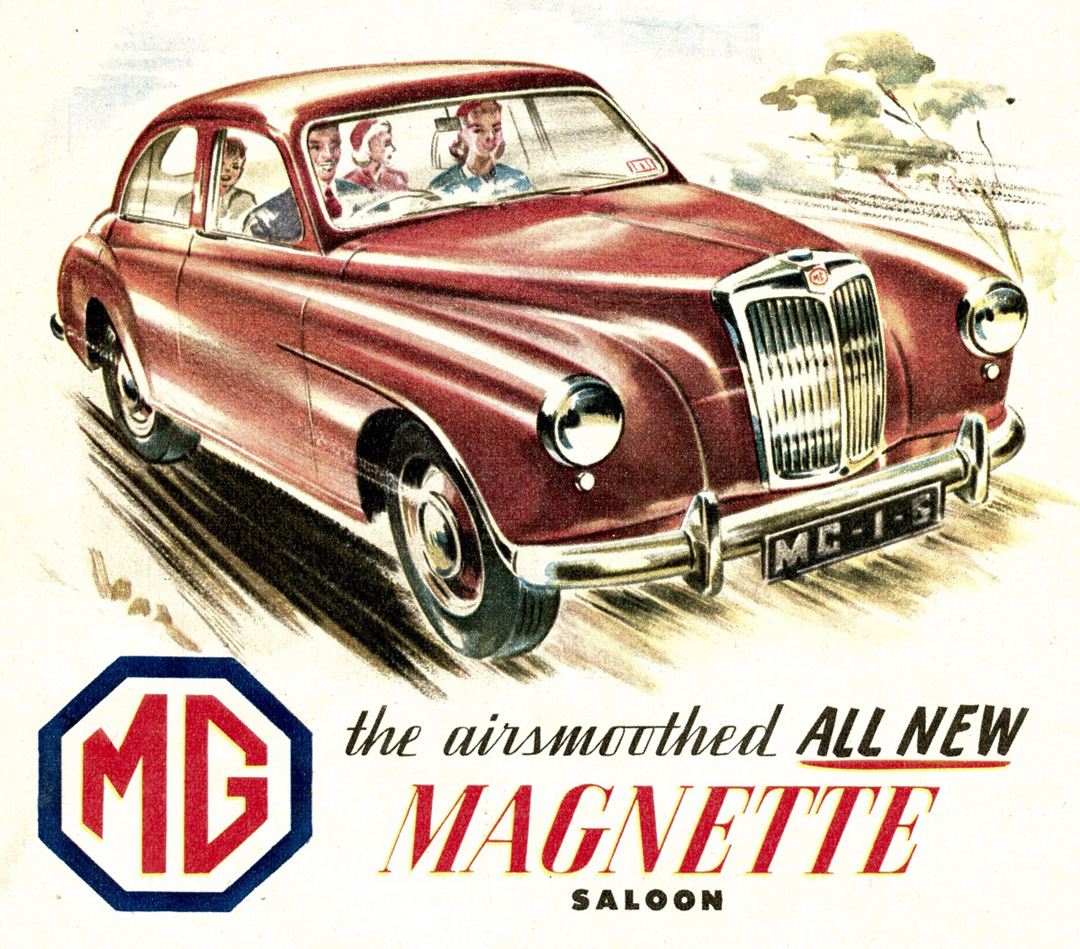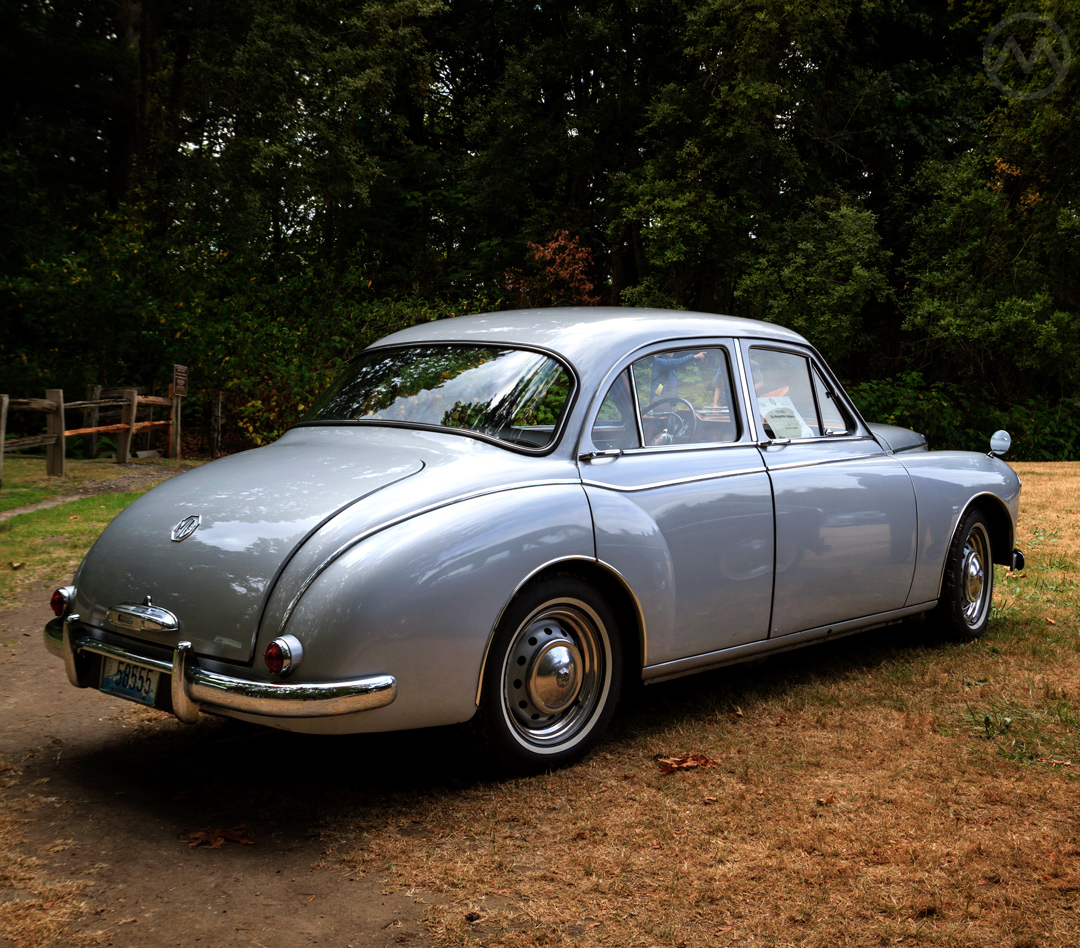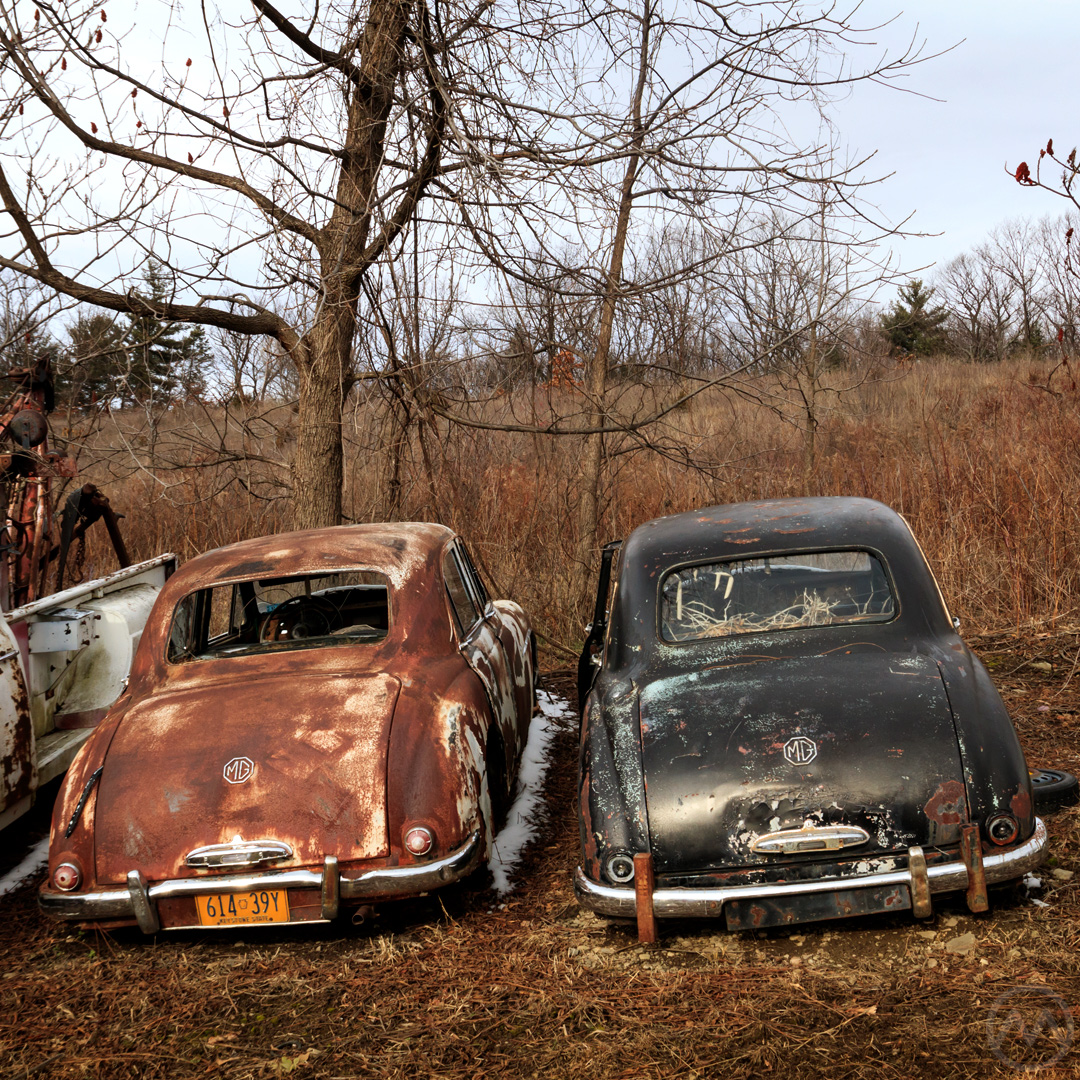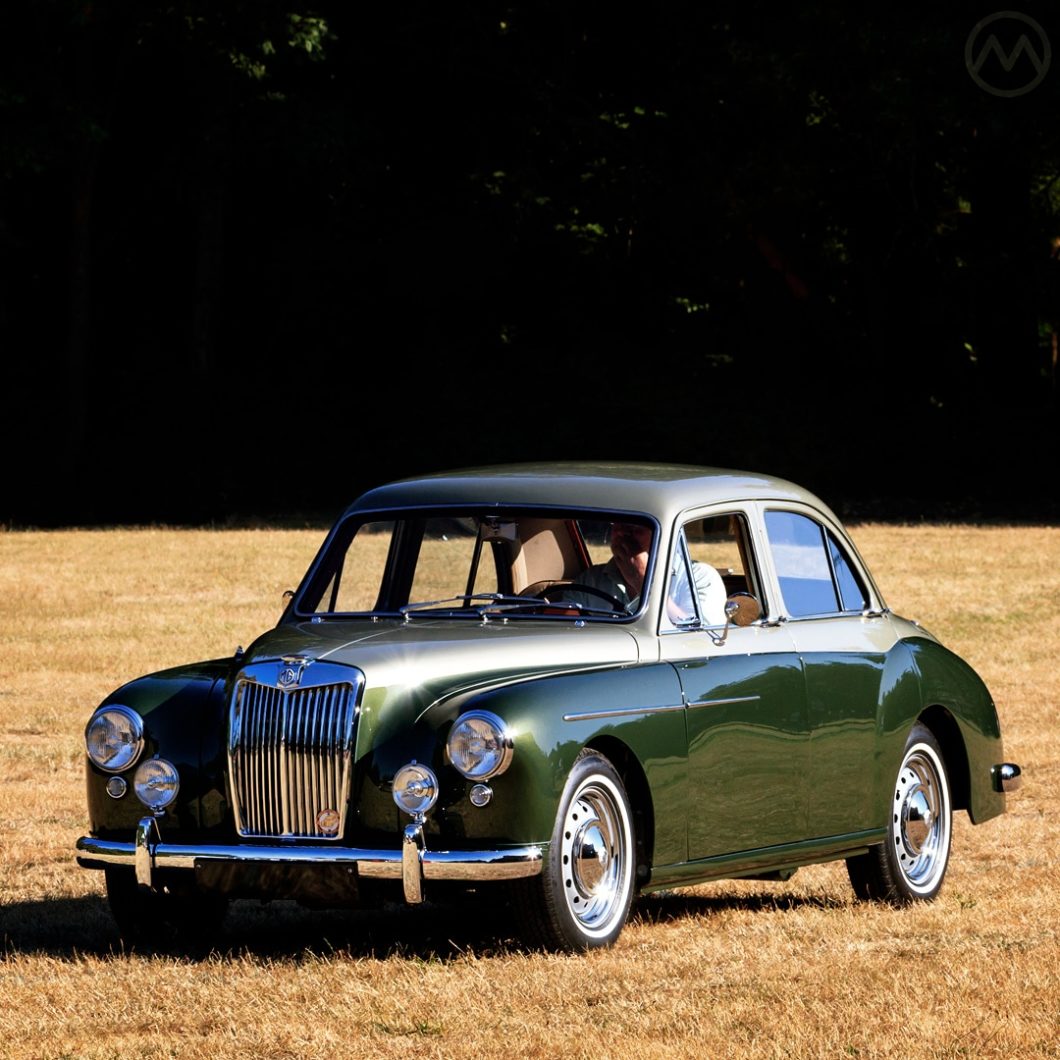MG is so closely associated with sports cars that some people forget the company always built family cars. The earliest MGs were, of course, just tuner car versions of Morrises, often complete with room for the family. By 1932 that included the K Magnette.
One of the best of MG’s family machines was the Z-magnette, built in two series (ZA and ZB) from early 1954 to late 1958. Though not built in big numbers by modern standards, the Z-Magnette became MG’s most successful family car up to that time.
The best of the Zs, though these things are always in the eye of the beholder, was probably the ZB “Varitone,” faster than the original ZA and more overtly stylish than the regular ZB (but still a tasteful looking machine). As the name implied, it sported two-tone color schemes and a wraparound rear window. Curiously the Varitone depicted in this story is in a single silver hue, while the car above is actually a regular ZB with two-tone paint.
The ZB also had numerous mechanical improvements over the earlier ZA, but we’ll get to that in a moment.
At first, it seemed like some of MG’s sports car fans had forgotten about those long ago MG “saloons,” because the initial launch of the ZA Magnette, an intentional callback to the old name, at the 1953 London Motor Show was met with a somewhat cool reception.
Said “purists” asked why it shared its shell with a Wolseley, and wondered even more why the Wolseley used the Morris/MG XPAW engine while the MG had an Austin-related four.
If those first fanboys didn’t like it, critics did. The engine in question was the long-lived B-series, and the ZA Magnette was the first car to use it in 1.5 liter form. It would soon become an MG mainstay. The sum of the parts was a light, sharp handling, good looking family machine, and a big improvement over the pre-war Y-type it replaced in terms of speed and comfort.
Gerald Palmer
The story of the Z-Magnettes begins when designer Gerald Palmer returned to the Nuffield Organisation (William Morris’ automotive empire) after a nearly decade-long stint at Jowett. That was in 1949 and within weeks of his arrival, he’d sketched out what became the new MG four years later.
Born in England 1911, Palmer grew up in Rhodesia, where his father was a railway engineer on assignment. The apple didn’t fall far from the tree – Palmer was always a tinkerer. At 15, he stripped and rebodied an old Model T Ford with boattail speedster design similar to one he’d seen on a Scripps-Booth.
His father wanted him to become an architect, but his interests (to the chagrin of his teachers) lay with vehicles. In 1927, he returned to England to become an apprentice, and later designer, with commercial vehicle maker Scammell.
With the blessing of his mentor at Scammell, the creative engineer O.D. North, he designed a privately-commissioned, Scammell-powered small sports car called the Deroy – but funding fell through after the prototype was completed. The Scammell engine also proved a bit underwhelming, which may not have helped prospects to sell the car.
The Deroy never got built, but Palmer kept the prototype and a few months after company was wound down, showed it to Cecil Kimber at Abingdon. At the time, William Morris had greatly reduced MG’s design talent pool after deciding to focus on volume produced cars in 1935. At the time, it was building the T-series and the big SA/WA/VA.

The MG design office had moved to Cowley, so Kimber sent Palmer and his Deroy to Vic Oak at the Morris design office, and Oak hired him on the strength of the Deroy prototype.
His first, and for awhile last, project there was working on the MG Y-type, which was finished in 1940 but mothballed because of the onset of the war. It returned in 1947 as a “new” car, but it looked distinctly old fashioned next to Palmer’s next project, the Jowett Javelin.
Car work at Cowley quickly turned to production of war material and specifically the de Haviland Tiger Moth. This wasn’t what Palmer wanted to do, and when he saw an ad for a design job with an unnamed car manufacturer – he leapt at. It turned out to be Jowett of Bradford.
He was given a considerable salary bump and total creative control (who doesn’t want those things?) to come to tiny Jowett in Bradford. There he and a small team designed the advanced Javelin and later the derivative Jupiter sports cars.
Easily the most advanced British car of the immediate postwar era, the flat-four, lightweight unibody Javelin, partly inspired by the Lincoln Zephyr and Nash 600, was a landmark machine but Jowett was too small to really make the car a proper success in the “export or die” era. With little on the horizon at Jowett, Palmer returned to Nuffield in mid-1949, now in a senior role thanks to his work on the Javelin.
Genesis of the Z Magnette
Later on, Palmer would say that there was virtually no strategy to the product planning at Nuffield, and that he was just asked to come up with whatever new designs for MG and Riley that he could. In 1977, Palmer told author Graham Robson that he’d been given no size or time targets.
The company had to devote much of its resources to the Minor and the MO Oxford (and a Wolseley derivative) after the war, and Riley and MG were using holdover products well into the 1950s.
At MG that meant the Y-type and the Y-type derived TD, both “new” cars but fundamentally old (and old-looking) designs. As in the era when the Y-type was designed, MG was to focus on volume cars, not small-production specials, so Palmer’s new projects would have to employ some platform sharing for cost reasons.
The smaller of these initial projects became the MG Magnette and the Wolseley 4/44. The larger, secondary ones the Riley Pathfinder and related Wolseley 6/90. In both cases, the Wolseley models were considered more essential as that brand sold in higher volumes than the others, but in both sizes the pair of models would help economies of scale – particularly with regard to Riley as the old Riley RM shared nothing with any other Nuffield cars.
The set of new machines were heavily influenced by Palmer’s trips to European shows and his admiration of the work of Pininfarina – but they were original shapes if vaguely Alfa/Lancia like in some ways.
Palmer had been a fan of the Italian coachbuilders since pouring over brochures and magazines as a boy in Rhodesia, so it wasn’t surprising that these cars caught his eye. Of particular interest were the Lancia Aurelia and a Touring-bodied Appia, the “Aerlux.”
The Magnette and the 4/44 would have, as with the Javelin, a light, tough unibody shell.
Supplier Pressed Steel did the body engineering to Palmer’s styling (executed almost solo), and would also build the shells, which were then sent to Cowley for Wolseley production and Abingdon for MG production. It was the first time that Abingdon would act as more an assembly facility than a complete factory, and the first time MG would build a unibody car.

To differentiate the pair, the MG would sit two inches (5cm) lower and use several unique panels. Because of the unibody construction, the occupants could sit much lower than in the full frame Y-type and the chassis was much more rigid and quiet. There was also far more room in the modern envelope-type body.
Before these cars could go into production, however, Nuffield merged with Austin into BMC in 1952. Because Wolseleys were not selling particularly well, the 4/44 was given launch priority over the MG version, and it debuted late that year. It retained the old Morris family engine partially for expediency’s sake, there wasn’t anything newer off the shelf yet.
The ZA & ZB
The ZA Magnette debuted a year later, by which time the merger had long been completed. Although production would not commence until 1954, at the heart of the new car was Austin’s new “B-series” engine, also seen in smaller form in the upcoming Morris Cowley and Austin A40 Cambridge around the same time.
Initial skepticism or no, the ZA looked good and drove well; its unibody shell, sharp front suspension, and optional radials augmented its light, sporty feel (for a family car). Its main drawback was a relatively low final drive, which made it buzzy on the highway – but that wasn’t too much of a problem at the time.
There was one serious issue before the cars went into full production. The lower-set body proved a little too low.
To avoid the danger of the propeller shaft hitting the transmission tunnel when the springs bottomed out, the early rear axles had a torque arm to point downward under heavy load. The torque arm caused horrible axle tramp on a test run, and at the last minute the rear axle had to be affixed to the springs in a more old-fashioned way – big U-bolts. Only 50 cars had been built at the time, and all were modified.
Sales started at a steady rate in 1954 and then shot up in 1955 – the car was a genuine hit compared to any previous MG “saloon.” Soon it was being built at a rate o 180 cars per week – much more than the Y-type.
Everything about the ZA was made better in late 1956 when it was refreshed into the ZB Magnette. Higher compression, bigger SU H4 carbs, and higher final drive made it faster, quieter, and longer-legged. In addition to these mechanical upgrades, the “Varitone” version added styling flair in a somewhat American way, although it was decidedly restrained compared to the later finned “Farina” Magnette.
The ZB debuted a “manu-matic” system that was MG’s first stab at offering an “Automatic” gearbox, but the complex semi-automatic system, actuated by a switch on the gear lever, proved unpopular. Most went to the USA, and ended up being refitted with regular manuals after a few years.
Palmer preferred the ZA, whos “hockey stick” chrome trims harkened back to the Touring “Aerlux.” He was, by 1954, no longer enamored of the corporate higher-ups at BMC, and often clashed with new boss Leonard Lord. He didn’t, ultimately, have much to do with the styling revisions that were made to turn the ZA into the ZB and the Varitone, having left BMC in 1955 for Vauxhall.
Z-cars Abroad and Onward
MG’s sports car success did not translate into big sales of its family cars in North America, but the Magnette seemed to fair alright – never a big seller but certainly not an Austin Atlantic-style bomb.
Even while production problems with the rear axle were still being ironed out, the first ZA Magnette for North America was on the boat, arriving in January, 1954. Real volume exports did not arrive until the following year, and Americans were more focused on the TF and, not long after, the MGA. Still, those who did try were rewarded with a quality car at a reasonable price.
But the Magnette was caught between the economy car world and the Detroit car world. The ZA and ZB were pricier than a Volvo 544 or a new Ford or Chevy for a 1.5L car, but you got a sophisticated package that was very well made and quite luxurious inside – filled with real wood for the town & country set. Even $2600 in 1959, it was cheaper than most mid-market American cars, just more expensive than “tiny foreigners.”
Sturdy cars and good drivers, in the U.K. the Z Magnettes later became favorites of banger racers, reducing their numbers. In the USA, many ended up donating their engines to MGAs in the 1970s, when their use as family cars was largely over and they were just old and cheap.

ZB production ended in late 1958, but it remained on sale into mid-’59. 36,600 were made in total. The more conventional – and more Morris-like – “Farina” Magnette replaced it, but didn’t have quite the same appeal.

